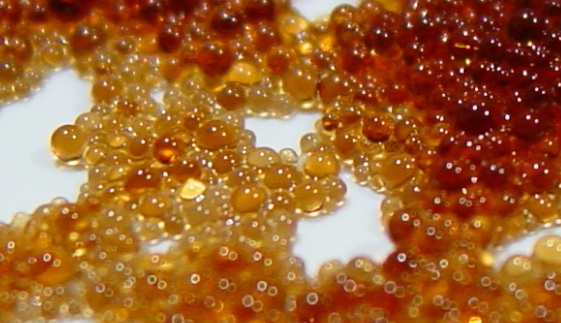|
DEAE-Sepharose
DEAE-Sepharose is a tradename for the anion-exchange reactive group, diethylaminoethanol (DEAE) covalently linked to Sepharose (a polysaccharide polymer A polymer (; Greek '' poly-'', "many" + ''-mer'', "part") is a substance or material consisting of very large molecules called macromolecules, composed of many repeating subunits. Due to their broad spectrum of properties, both synthetic a ...). References External links * Polysaccharides {{polymer-stub ... [...More Info...] [...Related Items...] OR: [Wikipedia] [Google] [Baidu] |
Ion Exchange
Ion exchange is a reversible interchange of one kind of ion present in an insoluble solid with another of like charge present in a solution surrounding the solid with the reaction being used especially for softening or making water demineralised, the purification of chemicals and separation of substances. Ion exchange usually describes a process of purification of aqueous solutions using solid polymeric ion-exchange resin. More precisely, the term encompasses a large variety of processes where ions are exchanged between two electrolytes. Aside from its use to purify drinking water, the technique is widely applied for purification and separation of a variety of industrially and medicinally important chemicals. Although the term usually refers to applications of synthetic (man-made) resins, it can include many other materials such as soil. Typical ion exchangers are ion-exchange resins (functionalized porous or gel polymer), zeolites, montmorillonite, clay, and soil humus. Ion exc ... [...More Info...] [...Related Items...] OR: [Wikipedia] [Google] [Baidu] |
Diethylaminoethanol
Diethylethanolamine (DEAE) is a chemical compound with the molecular formula C6H15NO. It is used as a precursor in the production of a variety of chemical commodities such as the local anesthetic procaine. It can be reacted with 4-aminobenzoic acid to make procaine. DEAE can be used as a precursor for DEAE-cellulose resin, which is commonly used in ion exchange chromatography. DEAE can also be conveniently obtained from renewable sources. It is chemically stable and able to absorb carbon dioxide (CO2) from its surroundings. In solution, it can decrease the surface tension of water when the temperature is increased. Applications Diethylethanolamine is used as a corrosion inhibitor in steam and condensate lines by neutralizing carbonic acid and scavenging oxygen. Preparation Diethylethanolamine is prepared commercially by the reaction of diethylamine and ethylene oxide. :(C2H5)2NH + cyclo(CH2CH2)O → (C2H5)2NCH2CH2OH It is also possible to prepare it by the reaction of diethy ... [...More Info...] [...Related Items...] OR: [Wikipedia] [Google] [Baidu] |
Sepharose
Sepharose is a tradename for a crosslinked, beaded-form of agarose, a polysaccharide polymer material extracted from seaweed. Its brand name is a portmanteau derived from Separation-Pharmacia-Agarose. A common application for the material is in chromatographic separations of biomolecules. Sepharose is a registered trademark of Cytiva (formerly: GE Healthcare and Pharmacia, Pharmacia LKB Biotechnology, Pharmacia Biotech, Amersham Pharmacia Biotech, and Amersham Biosciences). Various grades and chemistries of sepharose are available. Iodoacetyl functional groups can be added to selectively bind cysteine side chains and this method is often used to immobilize peptides. Sepharose/agarose, combined with some form of activation chemistry, is also used to immobilize enzymes, antibodies and other proteins and peptides through covalent attachment to the resin. Common activation chemistries include cyanogen bromide (CNBr) activation and reductive amination of aldehydes to attach proteins to ... [...More Info...] [...Related Items...] OR: [Wikipedia] [Google] [Baidu] |
Polysaccharide
Polysaccharides (), or polycarbohydrates, are the most abundant carbohydrates found in food. They are long chain polymeric carbohydrates composed of monosaccharide units bound together by glycosidic linkages. This carbohydrate can react with water (hydrolysis) using amylase enzymes as catalyst, which produces constituent sugars (monosaccharides, or oligosaccharides). They range in structure from linear to highly branched. Examples include storage polysaccharides such as starch, glycogen and galactogen and structural polysaccharides such as cellulose and chitin. Polysaccharides are often quite heterogeneous, containing slight modifications of the repeating unit. Depending on the structure, these macromolecules can have distinct properties from their monosaccharide building blocks. They may be amorphous or even insoluble in water. When all the monosaccharides in a polysaccharide are the same type, the polysaccharide is called a homopolysaccharide or homoglycan, but when more t ... [...More Info...] [...Related Items...] OR: [Wikipedia] [Google] [Baidu] |
Polymer
A polymer (; Greek '' poly-'', "many" + ''-mer'', "part") is a substance or material consisting of very large molecules called macromolecules, composed of many repeating subunits. Due to their broad spectrum of properties, both synthetic and natural polymers play essential and ubiquitous roles in everyday life. Polymers range from familiar synthetic plastics such as polystyrene to natural biopolymers such as DNA and proteins that are fundamental to biological structure and function. Polymers, both natural and synthetic, are created via polymerization of many small molecules, known as monomers. Their consequently large molecular mass, relative to small molecule compounds, produces unique physical properties including toughness, high elasticity, viscoelasticity, and a tendency to form amorphous and semicrystalline structures rather than crystals. The term "polymer" derives from the Greek word πολύς (''polus'', meaning "many, much") and μέρος (''meros'' ... [...More Info...] [...Related Items...] OR: [Wikipedia] [Google] [Baidu] |


